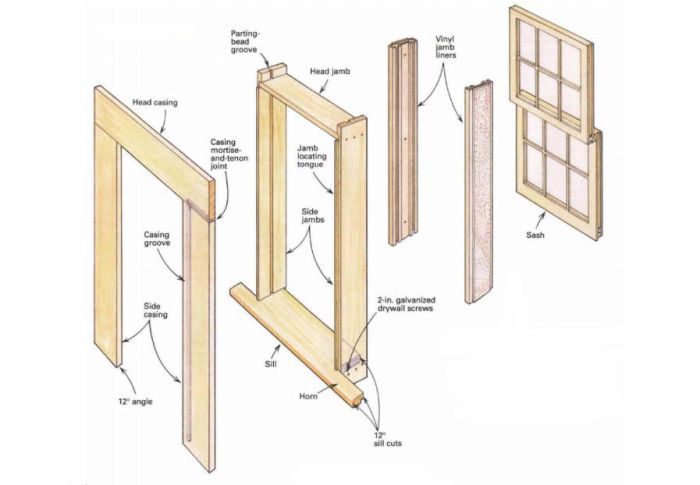DIY window frames offer a rewarding and cost-effective way to enhance your home’s aesthetic and functionality. Whether you’re replacing old windows, adding new ones, or simply upgrading the look of your existing frames, this guide will equip you with the knowledge and skills to create beautiful and durable windows.
From planning and design to construction and installation, we’ll cover every aspect of building your own window frames. We’ll explore the different materials available, provide step-by-step instructions, and offer tips for achieving professional-looking results.
Planning Your Window Frame Project: Diy Window Frame

Before you start building your window frame, it’s crucial to have a solid plan in place. This includes carefully measuring your window opening, considering the size and style of your frame, and choosing the right materials.
Measuring Window Openings
Accurately measuring your window opening is essential for ensuring your new frame fits perfectly. Here’s how to do it:
- Use a tape measure: Start by measuring the width and height of the window opening. Be sure to measure from the inside of the existing frame to the inside of the opposite frame.
- Check for squareness: Use a level to ensure the opening is square. If it’s not, you’ll need to adjust your measurements accordingly.
- Account for trim: If you’re planning to add trim around the frame, make sure to factor in the extra width and height.
- Measure multiple times: To avoid errors, measure the opening several times from different angles and record your measurements.
Window Frame Size and Style
Choosing the right size and style for your window frame will affect the look and functionality of your window.
- Standard sizes: Standard window sizes are often used for new construction and replacement windows. You can find pre-made window frames in these sizes, which can save you time and effort.
- Custom sizes: If your window opening is non-standard, you’ll need to create a custom frame. This gives you more flexibility in terms of size and style.
- Window frame styles: There are many different window frame styles available, including traditional, modern, and contemporary. Choose a style that complements the overall design of your home.
Choosing Materials
The materials you choose for your window frame will affect its durability, appearance, and cost. Some common materials include:
- Wood: Wood is a classic choice for window frames. It’s strong, durable, and can be stained or painted to match your decor.
- Vinyl: Vinyl is a low-maintenance and affordable option. It’s also resistant to rot, insects, and moisture.
- Aluminum: Aluminum is a lightweight and durable material. It’s often used for contemporary window frames.
- Fiberglass: Fiberglass is a strong and energy-efficient material. It’s also resistant to rot, insects, and moisture.
Adding Finishing Touches

Now that your window frame is assembled, it’s time to add the finishing touches that will make it look its best and function smoothly. This involves painting or staining the frame, adding trim or moldings, and installing window glazing and hardware.
Painting or Staining the Window Frame
Painting or staining your window frame is a crucial step in achieving a polished look. Choose a paint or stain that complements your home’s style and the overall design of the window.
- Prepare the surface: Before applying paint or stain, ensure the surface is clean, dry, and free of any debris. Sanding the surface lightly will create a smooth finish and help the paint or stain adhere better.
- Prime the surface: Priming the window frame is essential, especially for bare wood. Primer provides a barrier between the wood and the paint, preventing the wood from absorbing the paint and ensuring a more even finish.
- Apply paint or stain: Use a brush or roller to apply the paint or stain in thin, even coats. Allow each coat to dry completely before applying the next.
- Clean up: Once the paint or stain is dry, clean up any spills or drips with a damp cloth. Consider using painter’s tape to protect surrounding areas from accidental paint or stain.
Adding Trim or Moldings
Adding trim or moldings to your window frame can enhance its visual appeal and create a more finished look.
- Types of trim: There are various types of trim available, including casing, baseboard, crown molding, and chair rail. Choose the trim that best complements the style of your home and window.
- Installation: Trim is typically installed with a nail gun or hammer and nails. Ensure the trim is cut to size and properly aligned before securing it to the frame.
- Finishing: After installing the trim, paint or stain it to match the window frame or other elements in the room. You can also use a decorative finish, such as a glaze or wax, to add dimension and depth to the trim.
Installing Window Glazing and Hardware
Window glazing and hardware are essential for completing your window frame project.
- Glazing: Glazing is the process of securing the windowpane in the frame. There are various glazing methods, including putty glazing, silicone glazing, and glazing tape. Choose the method that is most appropriate for your window type and materials.
- Hardware: Window hardware includes items such as hinges, handles, latches, and sash stops. Choose hardware that is compatible with your window type and complements the overall style of your frame.
- Installation: Install the hardware according to the manufacturer’s instructions. Ensure that all screws and fasteners are securely in place.
Window Frame Construction Techniques

Building a strong and durable window frame is essential for a successful DIY project. The construction technique you choose directly impacts the longevity and stability of your window.
Traditional Joinery Techniques, Diy window frame
Traditional joinery methods involve precise cuts and joinery techniques to create strong and durable connections. These techniques have been used for centuries and are known for their strength and beauty.
- Mortise and Tenon: This technique involves cutting a rectangular hole (mortise) in one piece of wood and a corresponding projection (tenon) on the other. The tenon fits snugly into the mortise, creating a strong and durable joint. This method is particularly effective for window frames as it provides excellent stability and strength.
- Dovetail Joint: A dovetail joint is a strong and decorative joint that uses a series of interlocking wedges. This technique is commonly used for drawers and boxes, but it can also be used for window frames. The interlocking nature of the joint provides excellent strength and prevents the frame from coming apart.
- Lap Joint: A lap joint is a simple and strong joint that involves overlapping two pieces of wood. This technique is often used for window frames because it is relatively easy to create and provides good strength.
Modern Construction Techniques
Modern construction techniques offer efficient and often faster alternatives to traditional methods. These techniques often rely on fasteners and adhesives to create strong and durable connections.
- Pocket Hole Joinery: This method uses a jig to create angled holes in the wood, allowing for screws to be driven at an angle. This creates a strong and secure joint that is relatively easy to make.
- Glue and Dowel: This technique uses dowels and wood glue to create strong and durable joints. Dowels are inserted into pre-drilled holes, providing a stable and secure connection. This method is commonly used for window frames and other furniture projects.
- Metal Fasteners: Metal fasteners, such as screws and nails, can be used to assemble window frames. These fasteners are often used in conjunction with glue or other adhesives to create a strong and durable joint.
Impact of Construction Techniques on Strength and Longevity
The construction technique you choose will significantly impact the overall strength and longevity of your window frame. Traditional joinery methods, like mortise and tenon, are known for their exceptional strength and durability, providing a lasting and stable window frame.
Modern techniques like pocket hole joinery and glue and dowel offer efficient and often faster alternatives, but may require additional reinforcement depending on the specific application and the size of the window.
By embracing the DIY approach to window frames, you’ll not only save money but also gain a sense of accomplishment. With careful planning, attention to detail, and the right tools, you can create window frames that enhance the beauty and functionality of your home for years to come.
Creating a DIY window frame can be a fun and rewarding project, especially if you’re looking to add a unique touch to your home. While working on your frame, you might find yourself inspired by other DIY projects, like building a large Jenga game DIY. The process of stacking and balancing wood pieces for a giant Jenga game is similar to assembling a window frame, requiring precision and attention to detail.
Once you’ve mastered your window frame, you might find yourself drawn to tackling even more ambitious DIY projects.
